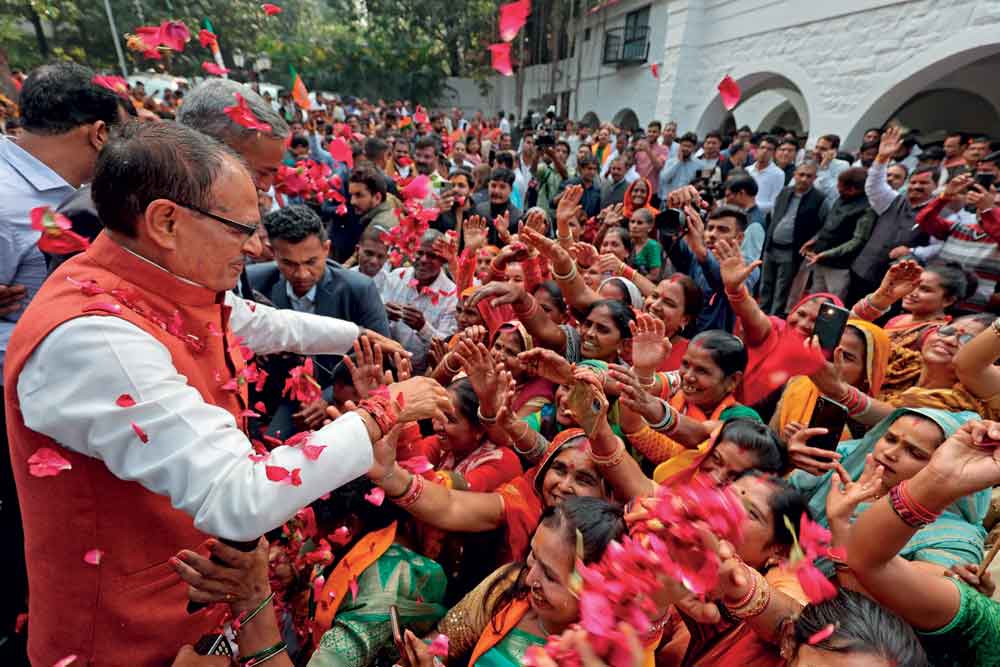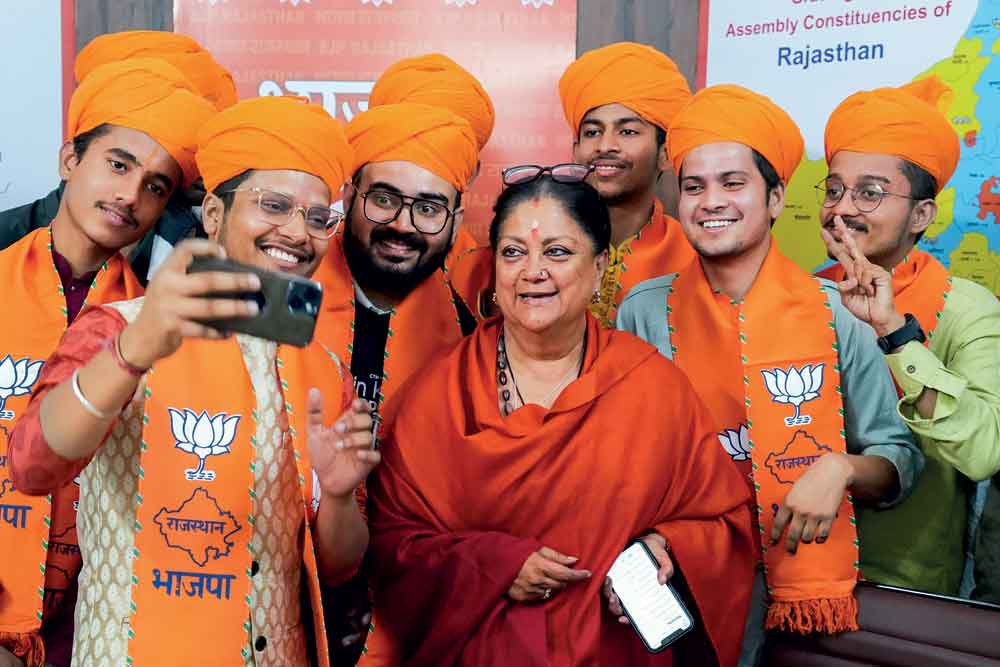The Enduring Modi Spell
India’s trust in the Prime Minister multiplies even as his detractors sink deeper in denial
/wp-content/uploads/2023/12/ModiSpell1.jpg)
Prime Minister Narendra Modi at BJP headquarters in New Delhi, December 3, 2023 (Photo: Getty Images)
SIGMUND FREUD DESCRIBED DENIAL AS A REFUSAL TO acknowledge upsetting facts about external events and internal ones. It comes with a long stream of red flags and a trail of breadcrumbs. Symptoms include refusing to talk about the problem, finding ways to justify odd behaviour, blaming others or outside forces for trouble, persisting with strange ways despite the negative consequences, and putting off problem-solving forever.
Not long ago, denial was among the least likely words to be used in politics. Not anymore. Today, it is far more likely to be used at both individual and organisational levels. Take, for instance, Hillary Clinton’s description of those not supporting her as “deplorables” during the 2016 US presidential campaign. Or closer home, the Indian National Congress suffering from a case of prolonged denial. So it is with the recent state Assembly elections whereby it received a drubbing in three of four key states despite its premature euphoria.
Defeat engenders humility among the vanquished. That’s to be expected because people who are very confident and go into battle based on prior assumptions feel deflated in the face of an adverse outcome. The sensible approach to working on the knots would be to study the issues and possible problems and try a different, more acceptable, approach. But often, there is little sign of failure or defeat encouraging people at the receiving end to pipe down, becoming more civil, acknowledge that they were wrong and then introspect. Congress is no exception to this pattern.
Immediately after the shock defeats, Congress leader Jairam Ramesh posted on X: “Exactly 20 years ago, the Indian National Congress lost the state elections in Chhattisgarh, Madhya Pradesh and Rajasthan, while winning only Delhi. But within a few months, the party bounced back and went on to emerge as the single largest party in the Lok Sabha polls and formed the government at the Centre. It is with hope, confidence and a firm sense of resolve and resilience that the Indian National Congress prepares for the forthcoming Lok Sabha polls. Judega Bharat, Jeetega INDIA!” The post itself red-flagged the biggest problem: Congress’ refusal to accept that political realities on the ground have changed radically in the last two decades.
“It is true that the performance of the Congress in Chhattisgarh, Madhya Pradesh, and Rajasthan was disappointing and far below our expectations. But the vote shares tell a story of a Congress that is not very behind the BJP—in fact, it is within striking distance. This is the reason for hope and revival. Chhattisgarh: BJP 46.3 percent, INC 42.2 percent; Madhya Pradesh: BJP 48.6 percent, INC 40.4 percent; Rajasthan: BJP 41.7 percent, INC 39.5 percent,” Ramesh posted, furthering the escapist narrative of his party.
One former Congressman describes Ramesh as a master of the “dilute, divert and digress” policy. Ramesh, who knows his mathematics, can offer such explanations even if the numbers are not that close. He had said after the Gujarat rout: “The election results in Gujarat are disappointing for us. The vote share of the Congress dropped from 40 percent to 27 percent. But a 27 percent vote share is a foundation and it is not difficult for us to again increase the vote share to 40 percent.”
The trust that Modi enjoys in this age of fickleness is indeed an enigma. Probably a beginning to decipher the puzzle could be made by accepting that his achievements are real and not the creation of the media
According to Kendra Cherry, a psychosocial rehabilitation specialist and author of The Everything Psychology Book, by refusing to deal with or even admit that there is something wrong, you are trying to prevent having to face stress, conflict, threats, fears, and anxieties. But denying that a problem exists allows the individual to continue engaging in destructive behaviour without addressing the problem or seeking a solution. In some cases, Cherry says, such attitudes can be problematic and even harmful. For example, if you stay in denial about a health condition and never see a doctor about it, the problem might worsen. The Congress leadership has persistently ignored the warnings and symptoms, to its own discredit.
Rahul Gandhi, apologist extraordinaire, once again “humbly” accepted the mandate of Madhya Pradesh, Chhattisgarh, and Rajasthan—polls pitched as a “semi-final to 2024” by Congress sympathisers—and insisted that “the battle of ideology will continue”. That’s an ‘ideology’ that, unlike with the Bharatiya Janata Party (BJP) and its allies, voters have been unable to fathom—between the attacks on Sanatana Dharma by its close ally in Tamil Nadu, the Dravida Munnetra Kazhagam (DMK), and his party’s Hindu-leaning electoral antics.
The Indian National Developmental Inclusive Alliance (I.N.D.I.A.) seems stuck in time, defining itself only by its opposition to Prime Minister Narendra Modi. In 2014, Congress responded to its humiliation at the hustings by blaming it on alleged tampering of EVMs with scarce evidence. The 2019 defeat—bigger than that in 2014—was blamed on money power, support of big corporations, and communal polarisation. Since each of these claims failed to strike a chord with the people, the party leadership has had to come up with a new excuse after the debacle in the just-concluded round: the ‘North vs South’ divide. A new xenophobic binary is being inserted into the discourse—the assumption that the majority of progressive and educated people, with far better social indices and, consequently, living standards, belong to the southern states. The insidious subsets are that scientific thinking, rationality, and more ‘progressive’ Western worldviews dominate the south of India which has rejected BJP while supporting Congress and its I.N.D.I.A. partners. Although the contours of the delimitation exercise are nowhere in sight, this spectre, too, is being milked to project a potential victimisation of the South by the North in terms of representation and amplifying the voice of its people.
While these straws may help them explain away the electoral defeat, they expose an unwillingness to come to terms with the reality that has changed politics in India: Narendra Modi. Certainly, one has to be wary of mono-causality—the fad of Marxian theoreticians for long used to describe the idea that a single cause can explain all social phenomena, thus oversimplifying the complex social and economic forces that shape society. But this victory of BJP was made possible primarily because of the trust that Modi still enjoys among the people of India.
The results of the recent state polls best illustrate this contention. The argument so far has been that while Modi’s appeal works in the national theatre, at the state level it runs into the harsh reality of local dynamics and often comes up short against powerful sub-regional aspirations and established local leadership. They also accuse Modi and Union Home Minister Amit Shah of cutting state leaders to size, replicating the Indira Gandhi model of an insecurity-driven disempowerment of regional satraps and their substitution with pliant nominees. But this election has outright called out such posturing as rhetorical excess.
Take the case of Rajasthan. BJP prevailed despite the freebie-fuelled, last-minute rally by Ashok Gehlot. And despite the fact that the BJP organisation there was inert for a while and riven with dissension, allowing Gehlot a free run. While consolidating his base, Gehlot was able to find new adherents through his populist promises. And the battle tilted Congress’ way—till Modi arrived on the scene. Soon, the inaction, lethargy and predictability of regional leaders got pushed to the background. Gehlot found himself pitted against Modi. The results clearly showed who prevailed.

In Madhya Pradesh, the huge mandate for BJP has overshadowed a simple fact—that the government was facing serious voter fatigue with a regime that has been there for close to two decades. Of course, Shivraj Singh Chouhan had done tremendous work to rescue the state from the shambles it was reduced to by Digvijaya Singh. But for all the goodwill that he had generated among women, Chouhan would not have been able to get the numbers for BJP had it not been turned into a battle where Modi himself was the chief combatant.
The decision not to project Chouhan as chief minister, the move to introduce Central leaders like Agriculture Minister Narendra Singh Tomar, Prahlad Patel, and reluctant colleagues like Kailash Vijayvargiya was a sound strategy to insulate the party against any possible unfavourable undercurrents.
Chouhan’s big successes were registered in the field of agriculture and in highly popular schemes like Ladli Behna, under which women in the 23-60 age group received ₹1,000 every month in their bank accounts. BJP promised that this would eventually go up to ₹3,000 a month in order to make women self-reliant and financially independent. Reports suggest that over the last 10 years—from 2013-14 to 2022-23—the state’s farm sector posted an average annual growth far surpassing the national average of 3.9 per cent during the period to touch 6.1 per cent. So did the gross cropped area from abysmal levels a decade earlier. He deserves credit also for expanding the irrigation network in the state from 40 per cent to 81.5 per cent in 10 years. He won plaudits for other reasons, too, most importantly in offering an assured minimum support price (MSP), especially for wheat. His Mukhyamantri Kisan Kalyan Yojana, which provided direct benefit transfers (DBTs), was also a big hit. However, Chouhan ran out of imagination and failed to move to the next level, that of securing big-ticket investments for the state. The BJP government was threatened with potential disenchantment, forcing the party to insulate its electoral chances with Modi rather than just banking on ‘Mamaji’. Although Congress faced the same threat with Ashok Gehlot in Rajasthan and was unable to elevate the state to the next level of growth and development, it failed to find a strategy to insulate the party’s electoral prospects the way BJP did in Madhya Pradesh. There was, in short, no political figure of Modi’s stature to build a campaign along the lines of the ‘Modi ke mann mei MP’ theme.
In Madhya Pradesh, the huge mandate for BJP has overshadowed the fact that the government was facing serious voter fatigue. Shivraj Singh Chouhan had done great work. But he would not have been able to get the numbers without Modi as the chief combatant
Chhattisgarh, though, may have delivered the unkindest cut at the hustings for Congress. It was a state that the party leaders nursed a sound solace in, even should they lose Madhya Pradesh (a longstanding BJP stronghold, longer, in fact, than Gujarat) and Rajasthan, despite Ashok Gehlot’s commitment to securing a win, explaining it away as part of unerring anti-incumbency in a state that changed the ruling party every five years. In Chhattisgarh, even senior leaders till a week before the election concluded that BJP stood no chance. But the party snatched defeat from the jaws of victory. There were leaders like Shah, however, who were confident of BJP getting 55 seats in the conviction that Modi could turn even lost battles around. That confidence appeared to have worked, with the winning combination of Modi, along with some adept tactical moves by Shah, making it possible. A vigorous, unrelenting campaign, with a firm focus on corruption, did the rest of the work.
Congress, its cohorts in the media, and its partners in the ever-proliferating civil society corps refused to accept the power of the Modi phenomenon. Not the least reason for this refusal is the fear of having to acknowledge that it would make Modi appear taller than the much-vaunted leaders of the Nehru-Gandhi family whose legacy they claim to represent. More importantly, it is the grudging awe that dogs the realisation that people’s trust in Modi persists even in an age when popularity rarely endures and new expectations rapidly outpace any goodwill generated by good governance.
The trust that Modi enjoys in this age of fickleness is indeed an enigma. Probably a beginning to decipher the puzzle could be made by accepting that his achievements are solid, real, and not the creation of the media. Free foodgrain for 80 crore people; the Ujjwala Yojana giving free cooking gas connections to the needy; prioritisation of potable water to all Indians; last-mile connectivity for power; medical insurance; four crore houses to the eligible, the “catch-all proposition”, and the great rescue act during the pandemic—all of these decisive measures, even in the face of intense criticism, have earned him the trust of the people. India’s economy grew at the fastest pace among major economies during lockdown thanks to multiple government initiatives, especially incentives for manufacturing. Most of these measures would not matter to people who are privileged or the entitled elite. But to the multitudes that live in rural India and poor clusters across the urban landscape, Modi’s decisions and policies have made a big difference to their lives, engendering expectations—based on what Modi has delivered—that he alone is trusted by voters to fulfil.

IT’S NOT JUST the poor who have benefitted. The results of the economic measures taken by Modi are beginning to manifest on the ground. The Goods and Services Tax (GST) collection continues to be robust, following an upward trajectory that shows it was a step in the right direction. The average gross monthly GST collection in the fiscal year 2023-24 now stands at ₹1.66 lakh crore and is 11 per cent more than that in the same period of the previous financial year. The GST revenue collection for October 2023 is the second highest ever. Inflation remains within tolerable limits. Capital markets continue to shine and forex levels had swelled by $12.8 billion to reach $572.8 billion as of March 17, 2023, according to data from the Reserve Bank of India (RBI). This is the highest level since early February 2023. More important is the infrastructure upgrade that has come as a surprise to people who had got accustomed to decrepit stretches of potholes that passed off as national highways. The Indian infrastructure sector’s market size is expected to grow from $186.24 billion in 2023 to $294.12 billion by 2028, at a CAGR of 9.57 per cent during the forecast period (2023-28), shored up by a plethora of roads, highways, stadiums, airports, Vande Bharat trains, and so on.
Although Congress faced a similar threat in Rajasthan, it failed to find a strategy to insulate the party’s electoral prospects the way BJP did in Madhya Pradesh. Congress had no political figure of Modi’s stature
What is equally important is the explosion of aspiration in India where the chalta hai attitude has long given way to the genuine big dreams of ordinary people. Modi’s performance, and the achievements that he has clocked, have generated the belief that India as a developed nation will no longer remain just a slogan, but that it has been transformed into achievable objectives. That’s the significant distance traversed, one that cannot be measured in mere numbers. There are, moreover, India’s growing geopolitical heft, the bombing of the Balakot terror factory inside Pakistan, the huge feat pulled off by soldiers on the Himlayas stunning the Chinese, the successful diplomatic initiatives—from the launch of the Solar Alliance to the highly successful G20 summit in New Delhi—and the ability to speak truth to the big guys at the global table.
Above all, there is the prime minister’s popularity that has exponentially boosted the confidence that India is now transitioning to the big league. Modi has fulfilled the long-felt aspirations of millions who were ashamed at India remaining confined to the world’s underprivileged club.
That revitalisation was also very apparent at the socio-psychological level, felt by millions of Hindus and the non-elite who were mocked and marginalised for decades for their beliefs even in independent India. Made to feel inferior because of the language they spoke and their lack of proficiency in English, they were relieved by Modi from an innate sense of inequality through booster shots of self-respect, confidence and pride regarding their language, religion, culture, and worldview.
This track record and his long list of achievements have helped Modi overcome the problem that was the bane of his predecessor—trust deficit. Not even Jawaharlal Nehru—who occupied the prime minister’s post as Mahatma Gandhi’s chosen one and dominated the political space for a long time with no big competitor in sight—was fortunate to enjoy the credibility that Modi today enjoys. His detractors may remain in denial, but this should interest social scientists and behavioural psychologists in how public trust makes a politician invincible. Not the least of the big connect that Modi enjoys today, 10 years into power in New Delhi, is his humble background. Born into a poor OBC family, his achievements, his simple language, his desire to scale every mountain in his path, despite his obvious social handicaps, all of these resonate with ordinary people who see him as one of them, a man who has made it big but never by disowning his roots.
About The Author
MOst Popular
3

/wp-content/uploads/2025/07/Cover-Shubman-Gill-1.jpg)













More Columns
Trump’s Disruption of World Trade Krishnan Srinivasan
Author Thomas Suárez presents peace framework for the Palestine-Israel crisis Ullekh NP
Shubhanshu Shukla Returns to Earth Open